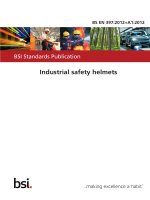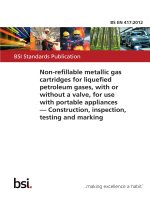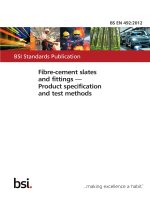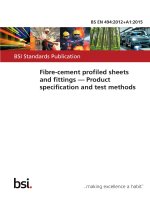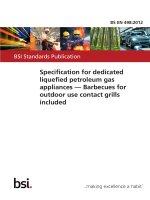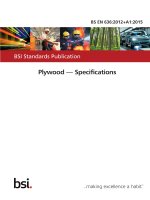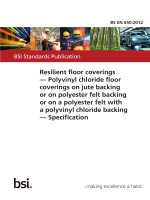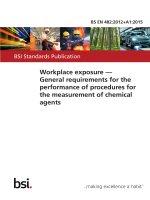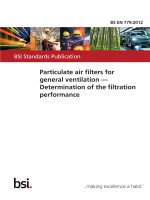Bsi bs en 61362 2012
Bạn đang xem bản rút gọn của tài liệu. Xem và tải ngay bản đầy đủ của tài liệu tại đây (1.91 MB, 70 trang )
BS EN 61362:2012
BSI Standards Publication
Guide to specification
of hydraulic turbine
governing systems
BRITISH STANDARD
BS EN 61362:2012
National foreword
This British Standard is the UK implementation of EN 61362:2012. It is
identical to IEC 61362:2012. It supersedes BS EN 61362:1998 which is
withdrawn.
The UK participation in its preparation was entrusted to Technical Committee
MCE/15, Hydraulic turbines.
A list of organizations represented on this committee can be obtained on
request to its secretary.
This publication does not purport to include all the necessary provisions of a
contract. Users are responsible for its correct application.
© The British Standards Institution 2012
Published by BSI Standards Limited 2012
ISBN 978 0 580 72947 8
ICS 27.140
Compliance with a British Standard cannot confer immunity from
legal obligations.
This British Standard was published under the authority of the Standards
Policy and Strategy Committee on 30 September 2012.
Amendments issued since publication
Amd. No.
Date
Text affected
BS EN 61362:2012
EUROPEAN STANDARD
EN 61362
NORME EUROPÉENNE
August 2012
EUROPÄISCHE NORM
ICS 27.140
Supersedes EN 61362:1998
English version
Guide to specification of hydraulic turbine governing systems
(IEC 61362:2012)
Guide pour la spécification des systèmes
de régulation des turbines hydrauliques
(CEI 61362:2012)
Leitfaden zur Spezifikation der
Regeleinrichtung von Wasserturbinen
(IEC 61362:2012)
This European Standard was approved by CENELEC on 2012-05-25. CENELEC members are bound to comply
with the CEN/CENELEC Internal Regulations which stipulate the conditions for giving this European Standard
the status of a national standard without any alteration.
Up-to-date lists and bibliographical references concerning such national standards may be obtained on
application to the CEN-CENELEC Management Centre or to any CENELEC member.
This European Standard exists in three official versions (English, French, German). A version in any other
language made by translation under the responsibility of a CENELEC member into its own language and notified
to the CEN-CENELEC Management Centre has the same status as the official versions.
CENELEC members are the national electrotechnical committees of Austria, Belgium, Bulgaria, Croatia, Cyprus,
the Czech Republic, Denmark, Estonia, Finland, Former Yugoslav Republic of Macedonia, France, Germany,
Greece, Hungary, Iceland, Ireland, Italy, Latvia, Lithuania, Luxembourg, Malta, the Netherlands, Norway, Poland,
Portugal, Romania, Slovakia, Slovenia, Spain, Sweden, Switzerland, Turkey and the United Kingdom.
CENELEC
European Committee for Electrotechnical Standardization
Comité Européen de Normalisation Electrotechnique
Europäisches Komitee für Elektrotechnische Normung
Management Centre: Avenue Marnix 17, B - 1000 Brussels
© 2012 CENELEC -
All rights of exploitation in any form and by any means reserved worldwide for CENELEC members.
Ref. No. EN 61362:2012 E
BS EN 61362:2012
EN 61362:2012
-2-
Foreword
The text of document 4/270/FDIS, future edition 2 of IEC 61362, prepared by IEC/TC 4 "Hydraulic
turbines" was submitted to the IEC-CENELEC parallel vote and approved by CENELEC as
EN 61362:2012.
The following dates are fixed:
•
latest date by which the document has
to be implemented at national level by
publication of an identical national
standard or by endorsement
(dop)
2013-02-28
•
latest date by which the national
standards conflicting with the
document have to be withdrawn
(dow)
2015-05-25
This document supersedes EN 61362:1998.
EN 61362:2012 includes the following significant technical changes with respect to EN 61362:1998:
This technical revision takes into account the experience with the guide during the last decade as well
as the progress in the state of the art of the underlying technologies.
Attention is drawn to the possibility that some of the elements of this document may be the subject of
patent rights. CENELEC [and/or CEN] shall not be held responsible for identifying any or all such
patent rights.
Endorsement notice
The text of the International Standard IEC 61362:2012 was approved by CENELEC as a European
Standard without any modification.
BS EN 61362:2012
EN 61362:2012
-3-
Annex ZA
(normative)
Normative references to international publications
with their corresponding European publications
The following documents, in whole or in part, are normatively referenced in this document and are
indispensable for its application. For dated references, only the edition cited applies. For undated
references, the latest edition of the referenced document (including any amendments) applies.
NOTE When an international publication has been modified by common modifications, indicated by (mod), the relevant EN/HD
applies.
Publication
Year
Title
EN/HD
Year
IEC 60050-351
2006
International Electrotechnical Vocabulary
(IEV) Part 351: Control technology
-
-
IEC 60068-2-6
2007
Environmental testing Part 2-6: Tests - Test Fc: Vibration
(sinusoidal)
EN 60068-2-6
2008
IEC 60068-2-27
2008
Environmental testing Part 2-27: Tests - Test Ea and guidance:
Shock
EN 60068-2-27
2009
IEC 60308
2005
Hydraulic turbines - Testing of control
systems
EN 60308
2005
IEC 61000-4-1
2006
Electromagnetic compatibility (EMC) EN 61000-4-1
Part 4-1: Testing and measurement
techniques - Overview of IEC 61000-4 series
2007
CISPR 11
(mod)
2009
Industrial, scientific and medical equipment - EN 55011
Radio-frequency disturbance characteristics
- Limits and methods of measurement
2009
ISO 3448
1992
Industrial liquid lubricants - ISO viscosity
classification
-
-
–2–
BS EN 61362:2012
61362 © IEC:2012
CONTENTS
INTRODUCTION ..................................................................................................................... 7
1
Scope ............................................................................................................................... 8
2
Normative references........................................................................................................ 8
3
Terms, definitions, symbols and units ................................................................................ 9
4
3.1 General terms and definitions .................................................................................. 9
3.2 Terms and definitions related to control levels and control modes ............................ 9
3.3 Terms and definitions from control theory ................................................................ 9
3.4 Subscripts and prefixes ......................................................................................... 10
3.5 Terms and definitions related to the plant and the machines ................................... 10
3.6 Terms and definitions relating to the governing system .......................................... 11
Control structure ............................................................................................................. 18
4.1
4.2
5
General ................................................................................................................. 18
Main control functions ............................................................................................ 18
4.2.1 General ..................................................................................................... 18
4.2.2 Speed control ............................................................................................ 19
4.2.3 Power output control .................................................................................. 19
4.2.4 Opening control ......................................................................................... 19
4.2.5 Water level control ..................................................................................... 19
4.2.6 Flow control ............................................................................................... 20
4.3 Configurations of combined control systems .......................................................... 20
4.3.1 General ..................................................................................................... 20
4.3.2 Parallel structure........................................................................................ 20
4.3.3 Series structures ........................................................................................ 21
4.3.4 Other configurations .................................................................................. 22
4.4 Configurations of servo-positioners ........................................................................ 23
4.5 Multiple control ...................................................................................................... 23
4.5.1 General ..................................................................................................... 23
4.5.2 Parallel structure........................................................................................ 24
4.5.3 Series structure ......................................................................................... 24
Performance and components of governing systems ....................................................... 24
5.1
5.2
5.3
5.4
5.5
General ................................................................................................................. 24
Modeling and digital simulation .............................................................................. 25
Characteristic parameters for PID-controllers ......................................................... 26
5.3.1 General ..................................................................................................... 26
5.3.2 Permanent droop b p ................................................................................... 27
5.3.3 Proportional action coefficient K p , integral action time T I , and
derivative action time T D ............................................................................ 27
Other parameters of the governing systems ........................................................... 28
5.4.1 Command signal adjustments for controlled variables (speed, power
output, etc.) and load limiter ....................................................................... 28
5.4.2 Governor insensitivity i x/2 ........................................................................... 28
5.4.3 Parameters of servo-positioner .................................................................. 29
Functional relationship between servo-positioners .................................................. 30
5.5.1 Dual regulation of turbines with controllable guide vane and runner
blade angles .............................................................................................. 30
BS EN 61362:2012
61362 © IEC:2012
5.6
5.7
5.8
5.9
5.10
5.11
5.12
5.13
5.14
5.15
5.16
5.17
6
5.18
How
–3–
5.5.2 Dual control of turbines with needles and deflectors ................................... 31
5.5.3 Multiple control .......................................................................................... 31
5.5.4 Other relationships ..................................................................................... 31
Actual signal measurement .................................................................................... 31
5.6.1 General ..................................................................................................... 31
5.6.2 Rotational speed ........................................................................................ 32
5.6.3 Power output ............................................................................................. 32
5.6.4 Water level ................................................................................................ 32
5.6.5 Actuator position (stroke) ........................................................................... 32
5.6.6 Signal transmission from electronic transmitters ......................................... 32
Manual control ....................................................................................................... 33
Linearization .......................................................................................................... 33
Follow-up controls ................................................................................................. 34
Optimization control ............................................................................................... 34
Monitoring parallel positioning of amplifiers ............................................................ 34
Provision of actuating energy ................................................................................. 34
5.12.1 General ..................................................................................................... 34
5.12.2 System with an accumulator ....................................................................... 35
5.12.3 Systems without accumulator ..................................................................... 38
5.12.4 Direct electric positioner ............................................................................ 39
5.12.5 Recommendation for hydraulic fluid selection ............................................. 40
Power supply for electronic control systems ........................................................... 40
Operational transitions ........................................................................................... 40
5.14.1 Start-up and synchronization ...................................................................... 40
5.14.2 Normal shutdown ....................................................................................... 41
5.14.3 Sudden load rejection ................................................................................ 41
5.14.4 Other operational transitions ...................................................................... 42
Safety devices/circuits ........................................................................................... 42
5.15.1 General ..................................................................................................... 42
5.15.2 Quick shutdown and emergency shutdown ................................................. 42
5.15.3 Overspeed protection device ...................................................................... 43
5.15.4 Interlocks ................................................................................................... 43
Supplementary equipment ..................................................................................... 43
5.16.1 Measures to reduce pressure variations ..................................................... 43
5.16.2 Surge control ............................................................................................. 43
5.16.3 Equipment and measures to lower the speed rise ....................................... 44
5.16.4 Central flow rate control in river power station systems ............................... 44
5.16.5 Brakes ....................................................................................................... 44
5.16.6 Synchronous condenser mode of operation ................................................ 45
Environmental suitability of governor components .................................................. 45
5.17.1 Vibration and shock resistance ................................................................... 45
5.17.2 Temperature and humidity ......................................................................... 45
Electromagnetic compatibility ................................................................................. 45
to apply the recommendations ................................................................................. 45
Annex A (normative) Simplified differential equations and transfer functions of idealized
PID-controllers ...................................................................................................................... 58
Annex B (informative) Grid frequency control ........................................................................ 60
Annex C (informative) Quick shutdown and emergency shutdown ......................................... 63
–4–
BS EN 61362:2012
61362 © IEC:2012
Figure 1 – Controlled variable range ...................................................................................... 12
Figure 2 – Permanent droop .................................................................................................. 12
Figure 3 – Proportional action coefficient and integral action time .......................................... 13
Figure 4 – Derivative time constant ....................................................................................... 14
Figure 5 – Dead band ............................................................................................................ 15
Figure 6 – Minimum servomotor opening/closing time ............................................................ 16
Figure 7 – Time constant of the servo-positioner ................................................................... 16
Figure 8 – Servo-positioner inaccuracy .................................................................................. 17
Figure 9 – Control system dead time ..................................................................................... 17
Figure 10 – Control system with speed and power output controllers in parallel ...................... 21
Figure 11 – Control system with speed controller and power command signal in parallel ........ 21
Figure 12 – Control system with speed controller and water level controller in parallel ........... 21
Figure 13 – Governing system with power output and speed controller in series .................... 22
Figure 14 – Governing system with water level controller and speed controller in series ......... 22
Figure 15 – Power output control via the speed controller ...................................................... 22
Figure 16 – Water level controller without speed controller .................................................... 23
Figure 17 – Parallel structure with defined functional relation and an additional signal
superimposition ..................................................................................................................... 24
Figure 18 – Series structure with defined functional relation and additional signal
superimposition ..................................................................................................................... 24
Figure 19 – Time step response and frequency response of the amplifier output Y/Y max
to a displacement input s v ..................................................................................................... 30
Figure 20 – Pressure tank content and pressure ranges ........................................................ 35
Figure 21 – Open-circuit system ............................................................................................ 39
Figure 22 – Start-up speed curve up to synchronization ......................................................... 41
Figure 23 – Load rejection ..................................................................................................... 42
Figure A.1 – Idealized PID in pure parallel structure............................................................... 59
Figure A.2 – Idealized PID alternative representation ............................................................. 59
Figure B.1 – Example of principle schematic functional diagram of a unit with a turbine
governing system using an idealized PID controller with a power droop .................................. 61
Figure B.2 – Behaviour of two units with different governor permanent droop values .............. 62
Table C.1 – Alternative I – Summary of cases for quick shut-down and emergency shutdown ..................................................................................................................................... 65
Table C.2 – Alternative II – Summary of cases for quick shut-down and emergency shutdown ..................................................................................................................................... 66
BS EN 61362:2012
61362 © IEC:2012
–7–
INTRODUCTION
While a standard for the testing of hydraulic turbine governing systems had been existing for a
very long time (IEC 60308 published in 1970) 1, a guide for the specification of hydraulic turbine
governing systems was missing until 1998. The need for such a guide became more and more
urgent with the fast development and the new possibilities especially of the digital components
of the governor.
The current second edition of the guide takes into account the experience with the guide during
the last decade as well as the progress in the state of the art of the underlying technologies.
While the first edition was written more or less as a supplement to the already existing guide
for testing, the objective of the second edition is to be the leading guide with respect to turbine
governing systems.
________
1
IEC 60308:1970, International code for testing of speed governing systems for hydraulic turbines. This
publication was withdrawn and replaced by IEC 60308:2005.
BS EN 61362:2012
61362 © IEC:2012
–8–
GUIDE TO SPECIFICATION OF HYDRAULIC TURBINE
GOVERNING SYSTEMS
1
Scope
This International Standard includes relevant technical data necessary to describe hydraulic
turbine governing systems and to define their performance. It is aimed at unifying and thus
facilitating the selection of relevant parameters in bidding specifications and technical bids. It
will also serve as a basis for setting up technical guarantees.
The scope of this standard is restricted to the turbine governing level. Additionally some
remarks about the control loops of the plant level and about primary and secondary frequency
control (see also Annex B) are made for better understanding without making a claim to be
complete.
Important topics covered by the guide are:
–
speed, power, water level, opening and flow (discharge) control for reaction and impulsetype turbines including double regulated machines;
–
means of providing actuating energy;
–
safety devices for emergency shutdown, etc.
To facilitate the setting up of specifications, this guide also includes data sheets, which are to
be filled out by the customer and the supplier in the various stages of the project and the
contract.
Acceptance tests, specific test procedures and guarantees are outside the scope of the guide;
those topics are covered by IEC 60308.
2
Normative references
The following documents, in whole or in part, are normatively referenced in this document and
are indispensable for its application. For dated references, only the edition cited applies. For
undated references, the latest edition of the referenced document (including any amendments)
applies.
IEC 60050-351:2006, International Electrotechnical Vocabulary – Part 351: Control technology
IEC 60068-2-6:2007, Environmental testing – Part 2-6: Tests – Test Fc: Vibration (sinusoidal)
IEC 60068-2-27:2008, Environmental testing – Part 2-27: Tests – Test Ea and guidance: Shock
IEC 60308:2005, Hydraulic turbines – Testing of control systems
IEC 61000-4-1:2006, Electromagnetic compatibility (EMC)
measurement techniques – Overview of IEC 61000-4 series
–
Part
4-1:
Testing
and
CISPR 11:2009, Industrial, scientific and medical equipment – Radio-frequency disturbance
characteristics – Limits and methods of measurement
ISO 3448:1992, Industrial liquid lubricants – ISO viscosity classification
BS EN 61362:2012
61362 © IEC:2012
3
–9–
Terms, definitions, symbols and units
For the purposes of this document, the following terms and definitions apply.
NOTE This guide uses as far as possible the terms and definitions of IEC 60050-351. For clarification, the
simplified differential equations and transfer functions of the idealized PID-controllers as used in this guide are
given in Annex A. Additional reference is made to IEC 60308 for purposes of tests of governing systems.
3.1
General terms and definitions
3.1.1
turbine governing system
technical equipment governing the opening (guide vane, runner blade, needle, deflector
position) of hydraulic turbines
Note 1 to entry At the present state of the art, the turbine governing system consists of an oil hydraulic and an
electronic part, the "oil hydraulic governor" and the "electronic governor".
3.2
Terms and definitions related to control levels and control modes
3.2.1
turbine governing level
control functions directly related to the governing system of a single turbine
Note 1 to entry
−
−
−
−
−
The following control modes are related to the turbine governing level:
speed control;
power output control;
water level control;
opening control;
flow control (the term flow used in this guide has the same meaning as the term discharge).
Note 2 to entry The scope of this standard is restricted to the turbine governing level. Additionally some remarks
about the control loops of the plant level and about primary and secondary frequency control (see Annex B) are
made for better understanding without making a claim to be complete.
3.2.2
unit control level
control functions directly related to the overall control of a single unit (turbine, generator, unit
auxiliaries) including turbine governing, voltage regulation, start-stop-sequencing etc.
3.2.3
plant control level
control functions related to the overall control of a whole plant including the control of several
units
Note 1 to entry In automatic unit and plant control operation, the turbine governing system gets its modes and
setpoints from the unit and plant control level.
3.2.4
grid control level
control functions related to the overall control of the grid as a whole
Note 1 to entry If required the turbine governing system participates in grid control over the primary and/or
secondary frequency control mode (see Annex B).
3.3
Terms and definitions from control theory
3.3.1
differential equation
equation describing the dynamic system behavior in the time-domain, as shown in Annex A
– 10 –
BS EN 61362:2012
61362 © IEC:2012
3.3.2
transient response
system response (output) to a step change of the input
3.3.3
frequency response
dynamic response of the linearized system to a sinusoidal change of the input signal derived
from the differential equation by applying the Fourier transformation
3.3.4
transfer function
dynamic response of the linearized system to an arbitrary variation of the input signal derived
from the differential equation by applying the Laplace transformation
3.4
Subscripts and prefixes
Subclause
Term
3.4.1
rated
subscript indicating the rated operation point of the system
3.4.2
maximum
minimum
subscript indicating maximum or minimum values of any term
3.4.3
deviation
3.4.4
Symbol
Unit
r
–
max.
min.
–
deviation of any term from a steady-state value
∆
–
guide vanes
subscript associating a quantity to guide vane position
ga
–
3.4.5
runner
subscript associating a quantity to runner blade position
ru
–
3.4.6
nozzle
subscript associating a quantity to needle position
ne
–
3.4.7
Deflector
subscript associating a quantity to deflector position
de
–
Symbol
Unit
E
J ⋅ kg –1
H
m
m 3 ⋅ s –1
3.5
Terms and definitions related to the plant and the machines
Subclause
a
Definition
Term
Definition
3.5.1
specific energy
of machine
specific energy of hydraulic water available between the highand low-pressure side sections of the machine
3.5.2
turbine head
H =E/g
3.5.3
flow
volume of water per unit time flowing through any section in
the system
Q
3.5.4
rotational
speed
number of revolutions per unit time
n
3.5.5
frequency
cycles per second
f
Hz
3.5.6
generator
power output
generator power measured at generator terminals
PG
W
3.5.7
moment of
inertia of mass
moment of inertia for calculation of fly-wheel effect.
I = M D 2 /4 = MR 2
(M = mass, D = diameter of gyration,
R = radius of gyration)
The unit rpm is frequently used.
definition of E, see 3.5.1
g = acceleration due to gravity
= 9,81 m⋅s –2 (at sea level)
I
s –1
kg
a
⋅ m2
BS EN 61362:2012
61362 © IEC:2012
3.6
– 11 –
Terms and definitions relating to the governing system
Subclause
3.6.1
Term
controlled
variable
Definition
Symbol
Unit
X
x
var.
–
–
rotational speed
xn
–
power output
xp
–
water level
xh
–
opening
xy
–
flow
xq
–
C
c
var.
–
rotational speed
cn
–
power output
cp
–
water level
ch
–
opening
cy
_
flow
cq
_
Y
y
m
–
X max
X min
–
–
variable which has to be controlled as speed n, output P G ,
water level h, servoposition opening y, flow Q:
– absolute, dimensional value
– relative deviation from a steady-state
value, x = ∆X/X r
3.6.2
3.6.3
command
signal
servomotor
stroke
a signal which can be set by an external adjustment:
– absolute, dimensional value
– relative deviation from a steady-state value, c = ∆C/C r
stroke of the main servomotor which moves the guide
vane/runner blades/needles/deflectors
– absolute value
– relative deviation from a steady-state value, y = ∆Y/Y max
Note 1 to entry The effective max. servomotor stroke Y max
has to be defined between customer and supplier.
3.6.4
controlled
variable range
adjusting range for the setting of a controlled variable
(rotational speed in speed control, or water level in level
control) with an average setting of the permanent droop, if
applicable (see 3.6.8 and 5.3.2):
–
maximum value of the controlled variable
for Y/Y max = 0
–
minimum value of the controlled variable
for Y/Y max = 1,0
SEE: Figure 1
BS EN 61362:2012
61362 © IEC:2012
– 12 –
X
Xmax.
0
1,0
Y
Ymax
Xmin
IEC 383/12
Figure 1 – Controlled variable range
Subclause
3.6.5
3.6.6
3.6.7
Term
Definition
electronic
governor output
signal
output signal at the electronic governor = input signal of the
following servo-positioner
output signal of
a pilot servopositioner
output signal of a pilot servo-positioner = input signal of
the following main servo-positioner
droop graph
a graph showing the relationship between a relative controlled
variable (speed n/n r , or in some cases water level H/H r ) as a
function of the relative servomotor stroke or the relative power
output under steady-state conditions
Relative deviation from a steady-state value
Relative deviation from a steady-state value
SEE: Figure 2
X
Xr
bp
0
1,0
bs
Y
, P
Ymax Pr
IEC 384/12
Figure 2 – Permanent droop
Symbol
Unit
s
–
sv
–
BS EN 61362:2012
61362 © IEC:2012
Subclause
3.6.8
3.6.9
a
– 13 –
Term
permanent
droop
proportional
action
coefficient a
Definition
Symbol
Unit
– at a specific point of operation,
bp
%
– defined by the end values of the droop graph
bs
%
Kp
–
slope of the droop graph (see Figure 2):
proportional amplification, defined by the step response of an
idealized PID-controller with bp = 0, KD = 0 and input signal x = 1
SEE: Figure 3
In accordance with IEC 60050-351.
s or Y (PI behaviour)
Kp
0
Ti = TI ⋅ K p
t
IEC 385/12
Figure 3 – Proportional action coefficient and integral action time
BS EN 61362:2012
61362 © IEC:2012
– 14 –
Subclause
3.6.10
Term
Definition
Symbol
Unit
integral action
time a
time constant of the integral action of an idealized PIDcontroller. The reset time T i in parallel structured PIDcontrollers is defined by T i = T I ⋅ K p and K p /T i corresponds to
the slope of the controller step response curve with b p = 0,
K D = 0 and input signal x = 1
TI
s
TD
s
SEE: Figure 3
3.6.11
derivative b
action time
time constant of the derivative action of an idealized PIDcontroller. The transfer function (T D ⋅ p) can practically be
realized only approximately by a DT 1 transfer function, i.e. a
derivative term multiplied by a first-order lag element c :
K 1D ⋅ T 1D ⋅ p
1 + T 1D ⋅ p
The step response of such a transfer function of an idealized
PID-controller, the proportional and integral term being zero, is
shown in Figure 4.
For small values of T 1D the following approximation applies:
T D = K 1D ⋅ T 1D
a
Reset time can also be defined by T i = K p /K I with integral action coefficient K I = 1/T I (see IEC 60050-351).
b
Rate time is defined in parallel structured PID-controllers by T d = K D /K p , with derivative action coefficient
K D = T D (see IEC 60050-351).
c
Realization also by second-order lag element possible.
s or Y (DT1 behaviour)
0,63 KD
K1D
t
0
T1D
IEC 386/12
Figure 4 – Derivative time constant
BS EN 61362:2012
61362 © IEC:2012
Subclause
Term
3.6.12
dead band
– 15 –
Definition
Symbol
Unit
the maximum band between two values inside of which the
variation of the controlled variable does not cause any
governing action
ix
–
i x/2
–
SEE: Figure 5
3.6.13
one-half of the dead band
insensitivity
X
Xr
ix
0
1,0
Y
Ymax
IEC 387/12
Figure 5 – Dead band
Subclause
3.6.14
Term
minimum servomotor opening/
closing time
Definition
the opening/closing time for one full servo-motor stroke at
maximum velocity, cushioning times disregarded
SEE: Figure 6
Note 1 to entry Minimum servomotor opening and closing
times are the result of hydraulic transient calculations.
Symbol
Unit
Tg, Tf
s
BS EN 61362:2012
61362 © IEC:2012
– 16 –
Y
Ymax
1,0
0
t
Tf
Tg
IEC 388/12
NOTE
In case of stepped opening/closing velocities a diagram may be provided.
Figure 6 – Minimum servomotor opening/closing time
Subclause
3.6.15
Term
time constant
of the servopositioner
Definition
Symbol
Unit
the reciprocal value of the slope of the curve showing the
servomotor velocity dy/dt as a function of the relative deviation
of the position of the control valve, s, s v , from the zero
position related to s, s v = 1 (s, s v = 1 theoretical relative spool
stroke in the absence of feedback)
Ty
s
SEE: Figure 7
dy
dt
1
Ty2
1
Tg
1
Tf
1
Ty1
1,0
s,sv
IEC 389/12
Figure 7 – Time constant of the servo-positioner
BS EN 61362:2012
61362 © IEC:2012
Subclause
3.6.16
– 17 –
Term
servopositioner
inaccuracy
Definition
the maximum possible change in the servomotor position
which can occur for a given constant value of the input
signal of the servo-positioner
Symbol
Unit
ia
–
Symbol
Unit
Tq
s
SEE: Figure 8
Y
Ymax
1,0
ia
0
1,0
s,sv
IEC 390/12
Figure 8 – Servo-positioner inaccuracy
Subclause
3.6.17
Term
control system
dead time
Definition
time interval between a specified change in speed or
command signal and the first detectable movement of the
servomotor
SEE: Figure 9
y
≥ 10 %
Tq
0
t
IEC 391/12
Figure 9 – Control system dead time
BS EN 61362:2012
61362 © IEC:2012
– 18 –
Subclause
Term
Definition
Symbol
Unit
3.6.18
actuating energy
required energy for one servomotor stroke under the
minimum required pressure p R = E R /V S
ER
N·m
3.6.19
servomotor
volume
oil volume of the servomotors
VS
m3
3.6.20
tripping oil volume
oil volume of the pressure tank at the tripping point
(between p T and p R , see Figure 20)
VT
m3
3.6.21
usable oil volume
(Figure 20)
usable oil volume between p o
Vu
m3
3.6.22
residual (not
usable) oil volume
(Figure 20)
oil volume of the pressure tank after a full-load shut-down
from the tripping point
V res
m3
3.6.23
design oil
pressure
design pressure of the oil pressure tank
pD
Pa a
3.6.24
operating oil
pressure
operating oil pressure under normal operating condition
po
Pa a
3.6.25
tripping oil
pressure
when the tripping pressure p T is reached a shutdown is
released, this implies p R < p T < p o < p D
pT
Pa a
3.6.26
minimum required
pressure
minimum required pressure in the oil servo system
pR
Pa a
a
min
and p R
The unit bar is also used.
4
Control structure
4.1
General
In the hydraulic turbine control, various tasks can be specified with varying priority. Realization
leads to certain typical control system structures and in turn to some basic rules to be adhered
to.
Such typical arrangements are compiled for clarification.
4.2
Main control functions
4.2.1
General
In hydraulic turbine control, these major control functions can be distinguished:
–
speed control;
–
power output control;
–
water level control;
–
opening, and
–
flow control.
In some systems, combinations of these control functions also occur.
BS EN 61362:2012
61362 © IEC:2012
4.2.2
– 19 –
Speed control
The purpose of the speed control basically is to maintain constant frequency. In the various
modes of operation this means that:
–
in the isolated network mode with only one unit (small network), the actual speed and
therefore the frequency corresponds to the command signal setting; in the isolated network
mode with more than one unit (medium network), the speed control contributes to the
frequency control through the permanent droop avoiding oscillation between the units;
–
in the operation on the grid, where the speed is determined by the network frequency, the
speed control contributes to the network frequency control through the permanent droop
and the dynamic characteristics of the controlled system;
–
in the no load mode (before synchronization and after separation from the network), the
actual speed corresponds to the command signal or the existing network frequency with
some small deviation.
4.2.3
Power output control
The power output control with a separate power controller is applied with the unit connected to
the grid, its purpose is to control the power output of the unit according to a power command
signal irrespective of head variations. Any frequency variations influence the power level
additionally via the permanent droop.
It is noted that in the cases where head variations can be ignored, a closed loop power output
control, i.e., a power output controller, may not be necessary. In such a case, the calculation of
the appropriate opening via a linearization may suffice (see 4.3.2). In this case also, any
frequency variations influence the power level additionally via the permanent speed droop.
4.2.4
Opening control
The opening control serves to position the opening of the servomotor according to an opening
command signal, either as a follow-up control in master control operations (for example speed
control) or as a specific operating mode in grid control. In that last case, the usual
configuration includes the permanent speed droop, which creates the relationship between the
frequency of the grid and the opening of the servomotor, around the opening set-point from the
unit control system; it is an alternative solution for power control with frequency influence,
which is the preferred solution using modern digital controllers.
4.2.5
Water level control
For run-of-the-river hydropower plants, it is often required to control the water level of the
upper part of the river, in order to keep it relatively constant or inside a specified range around
a fixed value. The corresponding water level control is usually operated by an external
controller of the power plant control system. But in some cases, it can also be managed by the
turbine governing system itself, especially if there is no need of grid frequency control.
In the first case, by using an external water level control, the water level controller operates as
a secondary controller. For that, it compares a water level measurement with a level set-point
or level limit values, and by a specific algorithm, modifies the command signal of the main
controller of the turbine governing system (speed or opening or power controller), in order to
control the water level. Attention should be paid, in case of participation of the unit to the
frequency control of the grid, that time constant of the water level control has to be enough
long, in order to allow the action of the primary frequency control, with a duration as required
by the TSO (transmission system operator) according to the corresponding grid code.
In the second case, the internal water level controller also compares the level measurement
with the level set-point or level limit values, and modifies the command signal to the servopositioners, or to the opening limiter of the speed controller. If there are several units in the
– 20 –
BS EN 61362:2012
61362 © IEC:2012
power plant, a level-opening droop (see 5.3.2) has to be implemented in each governor, in
order to fix the operating point of each unit.
4.2.6
Flow control
For run-of-the-river hydropower plants, especially in case of several cascade power plants
along a river (see 5.16.4), it can be required to control the flow across the different turbines in
operation in the concerned power plant. With that objective, a flow control system can be
implemented in the power plant control system or inside the turbine governing system.
In both cases, the usual configuration is as following: the flow controller compares a flow
"measurement" with a flow set-point, and by a specific flow control algorithm, modifies the
command signal to the servo-positioners or to the main controller of the turbine governing
system (speed or opening or power controller). The flow "measurement" is generally an indirect
measurement, i.e. calculated using characteristic curves from the runner blade opening (in
case of Kaplan or bulb turbines) or from the guide vane opening, if necessary with a
dependency on the measured head.
For Pelton turbines, the flow can be calculated from the position of each needle and the
measured head.
In case of participation of the unit to the frequency control of the grid, attention should be paid
that time constant of the flow control has to be long enough, in order to allow the action of the
primary frequency control, with a duration as required by the TSO (transmission system
operator) according to the corresponding grid code. In this case, another solution could be to
implement a flow controller directly in place of the opening or power controller, with a
“frequency-flow droop” using the difference between the flow set-point and the "measured" flow
(calculated as above).
4.3
4.3.1
Configurations of combined control systems
General
In combined systems, each control function can be assigned to a separate controller. However,
the controllers all actuate the same main servo-positioner through the opening setpoint.
Thereby, a bump-free switch-over between modes requires attention. In case of separate
controllers, parameters shall be set according to the respective control loop. Water level and
power output control, etc, are often incompatible with the maintenance of speed in an isolated
network. The speed controller always remains functional for safety reasons, e.g., to take over
in the case of a load rejection.
4.3.2
Parallel structure
Two controllers are arranged in parallel and actuate one or several servo-positioners via a
selector or a summing point. If a selector is applied, it often includes a max./min. function for
the speed control loop to prevail in the case of a load rejection.
If a summing point is applied, the switching of signals is avoided, but the power output
controller (or other controller) influences speed control additionally and shall be set to ensure
stability.
The configuration according to Figure 10 is often used in peak-load power stations.
BS EN 61362:2012
61362 © IEC:2012
– 21 –
Speed controller
Power output controller
IEC 392/12
Figure 10 – Control system with speed and power output controllers in parallel
Figure 11 shows an arrangement with speed controller and power command signal in parallel
according to 4.2.3.
Speed controller
IEC 393/12
Figure 11 – Control system with speed controller
and power command signal in parallel
Figure 12 shows a similar arrangement with water level controller.
Speed controller
IEC 394/12
Figure 12 – Control system with speed controller and water level
controller in parallel
4.3.3
Series structures
Power output controller or water level controller precedes the speed controller. They actuate
the speed signal setter of the speed controller (Figure 13) or the opening limiter (Figure 14).
In Figure 13 the power output controller actuates the speed signal setter of the speed
controller.
BS EN 61362:2012
61362 © IEC:2012
– 22 –
Power output controller
Speed controller
IEC 395/12
Figure 13 – Governing system with power output and
speed controller in series
In Figure 14 the water level controller actuates the opening limiter of the speed controller.
Speed
controller
IEC 396/12
Figure 14 – Governing system with water level controller
and speed controller in series
The configurations of Figures 13 and 14 are typical examples. However, there are also
configurations with the power output controller acting on the opening limiter of the speed
controller or with the water level controller acting on the speed signal setter. In the power
output and the water level control mode, the speed controller acts essentially as a positioner.
The configuration as per Figure 14 is often used in base-load power stations.
4.3.4
4.3.4.1
Other configurations
Power output control via the speed controller (power output introduced as
feedback signal)
Changeover between control modes is by switching from actual speed signal to the actual
power output signal (see Figure 15).
Speed
controller
IEC 397/12
Figure 15 – Power output control via the speed controller
BS EN 61362:2012
61362 © IEC:2012
4.3.4.2
– 23 –
Water level controller without speed controller
In simple cases (for example in the case of induction units), the water level controller acts on
the servo-positioner via a setter (see Figure 16).
IEC 398/12
Figure 16 – Water level controller without speed controller
4.4
Configurations of servo-positioners
Depending on the actuating energy required, the main servomotor can be:
–
directly actuated by an electro-hydraulic amplifier; the electronic feedback signal is fed back
to the governor;
–
actuated via a pilot servomotor; it positions a closed-loop hydro-mechanical follow-up
system consisting of main control valve, servomotor and mechanical feedback;
–
actuated via a piloted main control valve with parallel feedback signals from main control
valve and servomotor, etc.
The type of configuration has a bearing on positioning accuracy and manual control options.
4.5
Multiple control
4.5.1
General
In case of multiple control elements (e.g. dual control of a turbine with controllable guide vanes
and runner blades),
–
parallel (see Figure 17) and
–
series (see Figure 18)
arrangements are distinguished. The functional relationship can be defined non-linearly
through a function generator. Frequently an additional signal is superimposed (e.g. the head
can be used to influence the guide vane-blade angle relationship). In the case of more than two
positioners (e.g. individual servomotor control), only parallel control is applied.
